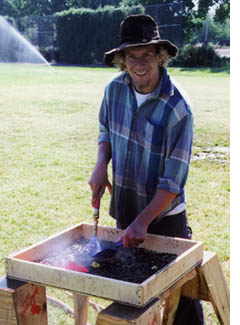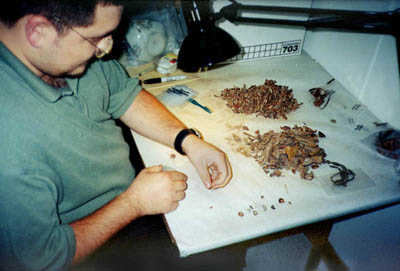A Woolen Mills Chinatown Archaeologist’s Journal -7
By Scott Baxter
Week of July 26: Lab Work in Progress

“Wet screening” soil for artifacts.
While excavation is the more visible – and many archaeologists would argue more fun – aspect of archaeology, we also have to do something with all the artifacts we collect. Called “lab work,” the processing of artifacts actually started at our excavations in San Jose. The Guadalupe River Parks and Gardens Association graciously provided facilities to “wet screen” and sort artifacts by material type with the help of volunteers from that organization and CHCP.
Since we finished our fieldwork in June, we have been working at the KEA Environmental lab in Sacramento processing the artifacts we excavated. Using simple toothbrushes and household scrubbers we remove 100 years of dirt from the materials we collected. Glass and ceramic objects are washed to help in this cleaning. Most metal and organic artifacts do not hold up well to water and are simply brushed to remove loose soil and corrosion.

Lab assistant John Vasquez sorts out some of the thousands of rusty metal bits recovered from our excavations. Much of this material is so corroded and fragmentary it is unidentifiable and will be discarded.
Identifiable metal, ceramics, glass, bone, etc. are labeled using a permanent ink pen. The labels identify the artifact’s location within the site and help us to interpret the use and life history of the dump and cooking feature we excavated. Once the artifacts are labeled, each one will be closely scrutinized and researched to determine it’s age, use, and origin. Faunal (bone) specialists Dr. Peter Schulz and Sherri Gust are looking at the bones we recovered from the site to determine the types and cuts of meats consumed at the Woolen Mills Chinatown. While we are cataloging and analyzing this material, Dr. Rebecca Allen and Anmarie Medin are busily writing up descriptions and interpretations of our field efforts at Woolen Mills and what was uncovered there. In the next few weeks we will begin our in-depth analysis of the materials we uncovered. Our next journal entry should include some photos and descriptions of the artifacts and their implications for our interpretation of the site.
Back to (Journal -1) Week of April 26, 1999: Is Archaeology Glamorous?
Back to (Journal -2) Week of May 3, 1999: Surprises and Ceramics
Back to (Journal -3) Week of May 10, 1999: Field Photos
Back to (Journal -4) Week of May 17, 1999: Uncovering a Sense of Place and Space
Back to (Journal -5) Week of May 24, 1999: Fieldwork Wraps Up
Back to (Journal -6) Week of June 7, 1999: Roasting Kettle?
Forward to (Journal -8) October 14-15, 1999: Volunteer Days
Working with Caltrans are archaeological consultants from the firms of Past Forward, Inc., KEA Environmental, Inc., Foothill Resources, Inc., PAR Environmental, Inc., and the University of California, Chico.

